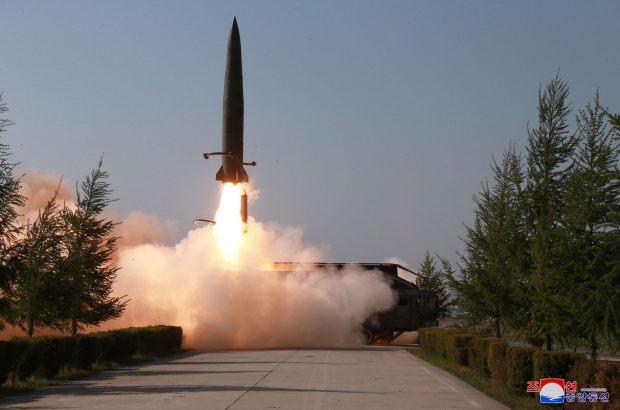N. Korea fires 2 short-range missiles into East Sea: JCS

North Korea on Thursday fired two short-range missiles toward the East Sea in what appears to be a move designed to put pressure on the United States and draw more concessions ahead of its possible nuclear talks with Washington. “North Korea fired one short-range missile at around 5:34 a.m. and the other at 5:57 a.m., from Hodo Peninsula near its eastern coastal town of Wonsan into the East Sea,” the Joint Chiefs of Staff (JCS) said. One missile flew around 430 kilometers and the other appeared to travel a bit farther based upon an analysis by the U.S. intelligence authorities, a JCS officer said, adding that both flew at an altitude of around 50 kilometers. They were presumed to have been fired from a transporter erector launcher (TEL) and landed in the East Sea, the officer noted. “We believe that (North Korean leader) Kim Jong-un has recently stayed in the region, and summertime military drills are now underway in the North,” he noted.
More analysis is needed to verify if they were ballistic missiles or not and whether they were the same type of short-range missiles that the North test-fired twice in May, according to the officer. “Our military is closely monitoring the situation in case of additional launches while maintaining a readiness posture,” the JCS said. Given the flight range, Pyongyang on Thursday appears to have test-fired its version of Russia’s Iskander ballistic missiles, just as it did back in May, according to experts.
On May 4, the North launched a fusillade of projectiles, which involved “a new type of tactical guided weapon” and 240-mm and 300-mm multiple rocket launcher systems. Five days later, it fired a barrage of projectiles, including two short-range missiles. Though Seoul and Washington have not confirmed the exact types of the missiles, Defense Minister Jeong Kyeong-doo said in early June that he believes the weapons North Korea fired in two rounds of tests in May were nearly the same type, though some differences have been spotted. If they are confirmed to be ballistic missiles, North Korea will be in violation of U.N. Security Council resolutions that ban Pyongyang from conducting all kinds of ballistic missile launches. The latest firings took place ahead of possible talks between Pyongyang and Washington on the North’s nuclear weapons program, though the outlook remains uncertain as Pyongyang appears to make dialogue contingent on joint drills that Seoul and Washington plan to hold next month.
In June, the North Korean leader and U.S. President Donald Trump agreed to resume their working-level talks within a few weeks, when they met at the inter-Korean border last month. Pyongyang has reportedly not responded to Washington’s offer for dialogue. It has also called the U.S. and South Korea to cancel their combined military exercise slated for August, warning that the drill would affect ongoing efforts to resume its nuclear talks. Despite such warnings, Seoul and Washington have said they are scheduled to launch the exercise as planned, stressing that the command post exercise is meant to test South Korea’s operational capabilities for the envisioned transfer of the wartime operational control. Thursday’s missile firing followed North Korean leader Kim’s recent field inspection of a newly built submarine. During the visit to an unspecified place, Kim called for the deployment of naval forces to boost his country’s military capabilities, according to the North’s Korean Central News Agency (KCNA) on Tuesday. “The latest saber-rattling by North Korea, albeit in low intensity, appears to have multiple purposes: It is an overt expression of its complaints over the Seoul-Washington joint military drills and is part of efforts to put more pressure on the U.S. so as to gain more concessions before the resumption of talks,” said Kim Dong-yup, a professor at Kyungnam University’s Far East Institute. “Internally, the North is aiming to persuade its military who may be discontented with such peace efforts, while sending messages to its people that its military might remains strong,” he added. A diplomatic source here said, “More time is needed before working-level talks resume, though we need more analysis of the latest military actions.”
Adding to the uncertainty, North Korean Foreign Minister Ri Yong-ho is also reportedly unlikely to attend the ASEAN Regional Forum (ARF) to be held in Thailand early next month, though it has sent its foreign minister to the forum every year since 2003. In response to Thursday’s firing, South Korea’s defense ministry called on Pyongyang “to stop such acts that do not help efforts for easing military tensions on the Korean Peninsula” and vowed to ramp up surveillance in close cooperation with the U.S. North Korea test-fired the Hwasong-15 intercontinental ballistic missile (ICBM) in November 2017, and leader Kim has since declared a moratorium on nuclear and ICBM tests.
By Oh Seok-min
(Yonhap)

























































